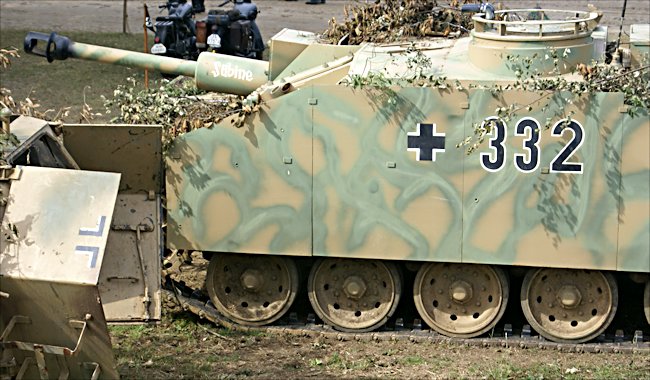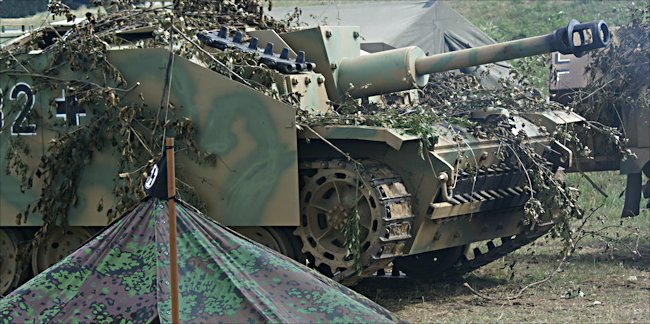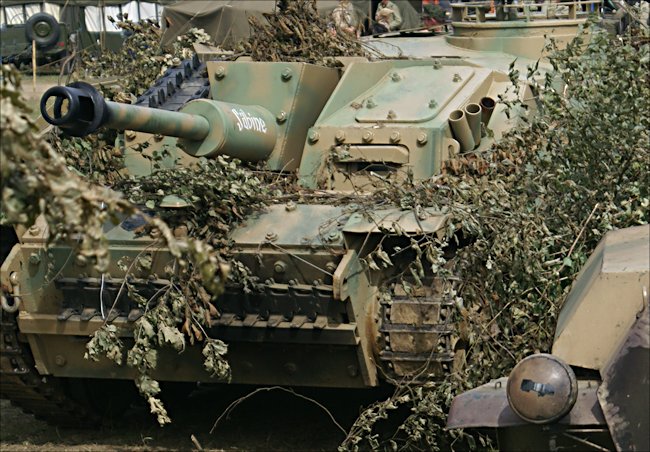The StuG III tank replica 332
This German StuG III tank destroyer replica 332 with Schürzen side-armor panels is in private ownership and is often seen at military vehicle events in the summer in Britain like the annual "War and Peace" Show in Folkestone. The upper hull was built on top of a British cold war era FV432 armoured personnel carrier chassis.

German StuG III tank destroyer replica 332
It was in 1936 that the German High Command authorise the development of assault vehicles that would become one of the most important types of armoured fighting vehicle of World War II for the Panzer Divisions. They were cheap to make and easier to produce compared with a tank.
Five prototypes using the Panzer III Ausf B chassis were built in 1937. Main production of the StuG III Ausf A started in January 1940. Models Ausf B to E looked very similar only having minor improvements. The model StuG III Ausf F and an improved hull design and longer gun.
Just 24 StuG III assault guns were in service in time for the May 1940 blitzkrieg attack on France through the Belgium Ardennes. Their success as an infantry support weapon was out of all proportion to the amount of vehicles in action. Official German army wisdom at the time was that assault guns were not to be employed in anti-tank role, practicality required them to knock out enemy tanks within the vicinity.

German StuG III tank destroyer replica 332
The real well battlefield experience showed that these assault guns were better suited as tank destroyers. StuG III's were from that date used as anti-tank weapons. During the battle of France these vehicles showed they could knock out enemy tanks using their 75mm StuK 37 L/24 gun. This was something that the German tanks found they could not do using the underpowered guns fitted to the turrets in 1940. German tank crews were horrified when they saw their shells bounced off the frontal armour of British Matilda tanks and French char B heavy tanks.
When Hitler decided to attack Russia in operation Barbarossa, the numbers of Sturmgeschütz III assault guns available to the German army had increased considerably. The Sturm (storm) artillery had undergone and expansion and changing in organisation. Assault Battalions each fielding three batteries of six StuG IIIs. For the opening of the Eastern front proximally 108 StuG IIIs were distributed across army groups North Centre and South. They all saw heavy fighting.
Again the senior officers in the German army used the StuG IIIs in an infantry support role but because of the large waves of Russian armoured vehicles sent to stop the German advance, they were again called upon to be anti-tank destroyers to protect the infantry they had been tasked to look after.

German StuG III tank destroyer replica 332
In 1941, the types of Russian tanks sent against the Germans, were in the main light and medium types. The StuG III's gun could easily penetrate their armour. The problem came later when they were confronted by the Russian T 34/76 tank with its sloping front armour and KV-1 heavy tank. Just like the Panzer IV tank that shared the same low velocity main 75mm StuK 37 L/24 cannon that was optimised to fire close support high explosive shells HE.
Of the 44 rounds normally carried by the StuG IIIs 80% were HE and only a token were armour piercing. Even when the AP shells were used low velocity of the cannon sometimes did not give enough inertia for the shells to penetrate the thick enemy armour of the new Russian tanks.
Yet StuG IIIs did manage to destroy some of these new Russian monsters. This was down to the German crews technical proficiency and aiming at known weak spots. Their gunnery was rapid and accurate. They survived return fire, by having relatively high frontal armour and a low profile, making them difficult to hit. By 1944 the German assault battalions would claim over 20,000 Russian armoured vehicles destroyed.
As the German armies moved further into Russia the assault battalions were constantly in action as Russian forces were encircled great pockets. They were reduced by infantry and assault artillery. Tank crews that manned the StuG III assault guns were often used as a fire brigade to stop Russian forces tried to break out towards the East.
StuG IIIs were used in clearing Russian strong points in city centres. They were supported by machine gun units in armoured half tracks. Replacement StuG III assault guns were quickly delivered to the front by train. They were small enough to fit on the back of a flat back wagon.
By the end of September 1941, the Germans launched operation Typhoon in an attempt to capture Moscow before winter. It failed, but StuG IIIs were used throughout this operation. With the onset of a very bad Russian winter the German tank crews to learn how to keep their vehicles running in the intense cold. They had to stop the engine fluids and the grease on the gun mechanisms freezing and ice forming on their gun optics. Keeping a StuG in a condition to fight in these conditions was very hard work
WW2 tank books

